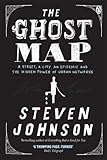A few months ago I spent some time exploring my wife’s family tree. One fragment of jigsaw was a census return from 1851 showing one of her 3–greats-grandfathers, then age 16, living with his parents at 13 Cambridge Street in Soho.
I looked at the current London street map and found there is no Cambridge Street in Soho any more, and that was the end of my curiosity.
Skip forward to last week, and I finally got around to reading Ghost Map by Steven Johnson.
Johnson takes as his central theme the story of John Snow, and his pioneering work with Henry Whitehead during and after the 1854 cholera outbreak in Soho which proved for the first time that cholera was a water-borne infection.
One of the key tools used by Snow was to plot the course of the outbreak on a map. Looking at the map I realised I had found Cambridge Street – the old name for the upper part of what is now Lexington Street.
The slightly more detailed general Board of Health Map based on Snow’s work also shows the old house numbers – and this shows number 13, just 7 doors down from the infamous pump which spread the disease.
The coincidence is that a direct ancestor of my wife lived in a house which, three years after evidence of their residence, was in the centre of a particularly virulent and well-documented outbreak of cholera. Today, in a modern city, that would be worthy of comment: in Victorian London perhaps less so.
We have no way of knowing if they were still in residence three years after the census, and thus survivors of the outbreak, but even if they had moved on, the descriptions of the Broad Street area provide a fascinating insight into the circumstances in which they lived.
More interesting, to me at least, are the aspects of my curiosity which set up this piece of serendipitous discovery – family history, networks of connections, a lifelong fascination with maps and the story they tell, and the ever-fascinating mental game of “What if… ?”


